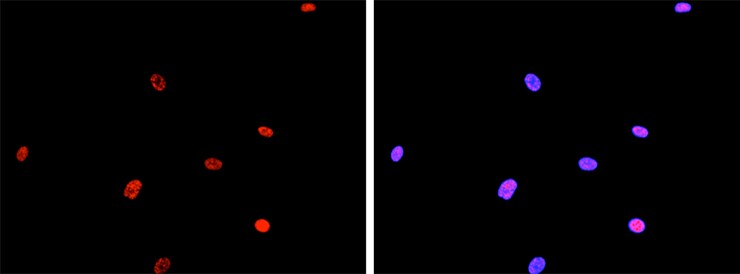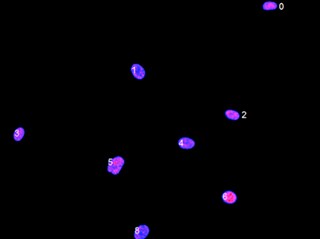Search Thermo Fisher Scientific
- Order Status
- Quick Order
-
Don't have an account ? Create Account
Search Thermo Fisher Scientific
Digital images are easily manipulated. Accurate, reliable results depend on the application of consistent equipment settings, comparative assessments through replicate analysis and the use of controls, and consistent background correction.
Learn the basic guidelines for image manipulation, how to obtain reliable fluorescence intensity data, how to subtract background, and how to use replicates to improve the reliability of your observations.
Quantitation in fluorescence imaging can get quite tricky. One of the easiest ways to analyze images is to compare the fluorescence intensity of one region of interest to another. This is often referred to as relative quantitation. To help ensure that the results you get are reliable, remember to:
Usually the software program that you use to acquire your images on the microscope will have some analysis capabilities. There are also programs like ImageJ that can be used to perform various types of image analysis. It will be up to you to decide what area of your image you are interested in quantifying.
A region of interest (ROI) is an area within your image that you are interested in quantifying in some way. Typically, software programs can provide fluorescence intensity values for a defined ROI. You can define a ROI either by outlining the area manually (i.e., drawing a circle around it) or by defining a threshold (so that all intensities above a certain value are counted). Some software programs refer to the selection of areas to quantify as masking. The mask flags a ROI that the software will recognize.
Figure 1. Example of defining ROIs using an intensity threshold. The nucleus of each cell is labeled using a nuclear stain (red, left) and the user can then specify an intensity threshold. The software then overlays a mask (blue overlaid on red, right) on the regions that meet the specified threshold. Masking gives you a visual check that the threshold you’ve set includes all of the objects you’re interested in, before you begin your quantitation and analysis.
In this example, the raw image is on the left. Nuclei were stained and are shown in red. To define regions of interest (ROI) that represent the nuclei of each cell, a thresholding method was used. This means that all pixels above a certain intensity are included in the ROI. In the analysis program used in this example, the pixels that meet the threshold are highlighted in blue, and the blue highlighted ROIs are overlaid on the red nuclei to generate a purple color (image on the right).
You could get an average intensity for all the nuclei in the entire image, or you can get additional details by counting each object. In the simplest cases, an object will equal one cell.
Figure 2. Example of identifying individual objects. Each nuclei is counted as an individual object with its corresponding intensity value given, instead of an average intensity for all nuclei in the field.
The advantage of defining individual objects in your image is that you can get fluorescence intensity information for each object. For example, cell #1 has an intensity of x, cell #2 has an intensity of y, etc. And if you want to, you can use the individual intensity values to derive an average intensity for all the cells in the image.
One way to obtain relative intensity comparisons between control and treated samples is to first define regions of interest for each image (using the same method of region defining for both). Then count the number of cells in the field and calculate an average intensity value per cell. Compare this value for both control and treated samples. Of course, you can do this comparison without counting the number of cells by just using the average intensity value of the entire region of interest (or regions of interest within the image).
Background fluorescence is the fluorescence that is not specific to your experiment. The specific fluorescence that you do want is often called “signal”. Background needs to be subtracted from true signal within the region of interest; otherwise, background will contribute to the apparent “signal” and give you an incorrect value. In reality, in some experiments, the background in both the control and treated samples is very similar. When this is the case, it can be okay to skip the background subtraction step. Skipping this step is really at the discretion of the experimenter, but before you do so, make sure you have checked (and can prove you have checked) that the background signals were the same (or very similar) between the control and treated samples.
To subtract background, first determine the fluorescence intensity of the background by drawing a region that is close to the defined region of interest (see previous section) but doesn’t have a fluorophore specifically bound to a target. For cells, this would be an area that has no cells present. Use the fluorescence intensity in this neighboring region as the value for the background intensity. Finally, subtract this value from the intensity values for the regions of interest.
Cell biologists often do experiments to discover causal relationships between various molecules, and showing that two molecules are very close to each other in the cell—called co-localization—is one piece of evidence that they are interacting with each other. When imaging with epifluorescence illumination, it’s actually quite difficult to determine co-localization, mainly due to limits in resolution. Most microscopes cannot distinguish between two objects that are less than 200 nm apart. To complicate things even more, this limit extends to the entire 3-dimensional volume (x, y, and z planes). So practically, if you have labeled protein X with a fluorophore that emits in the green channel and protein Y with a fluorophore that emits in the red channel, and in the image you see that the green and red pixels are on top of each other, you can definitively say only that both proteins exist within a specific 3-dimensional volume, and how big or small this volume is will depend on the resolution limits of your microscope. True co-localization requires more specialized microscopes as well as plenty of technical skill, controls, and math.
Replicates are important in any type of quantitative analysis. Replicates allow you to sample more, and this gives you added information about what is actually significant. Performing replicates helps provide a certain amount of confidence that what you are seeing is really happening and not just a random event. More importantly, replicates allow you to perform statistics and report probability of significance, which is necessary in order to convince others that your data are meaningful.
Here are some ways to add replicates to your quantitative analysis:
Most image acquisition software will allow you to adjust the brightness, contrast, and color of your image after you have taken it, or to crop the image to retain just the areas you want to emphasize. There are many situations where adjustments are perfectly within the bounds of good scientific conduct. Cropping an image to focus the eye only on the area important in the field of view, or adjusting the brightness and contrast to clean up the background and make the details more visible, are very commonly done and can help the viewer understand your image better. However, always make sure you save the file of the original “raw” image, and save the manipulated images with different file names.
If you perform post-acquisition manipulations on your image, use good judgment and avoid manipulations that could cause people to question your scientific integrity. Here are a few things to keep in mind:
For Research Use Only. Not for use in diagnostic procedures.


